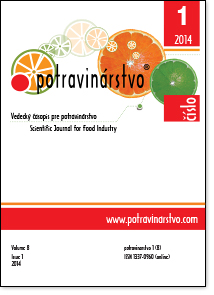Evaluation and comparison of the content of total polyphenols and antioxidant activity in onion, garlic and leek
DOI:
https://doi.org/10.5219/394Keywords:
onion, garlic, leek, total polyphenols, antioxidant activityAbstract
Onion, leek and garlic as onion family are a great source of freely available health-promoting and chemoprotective compounds (polyphenols, flavonoids, fructooligosaccharides, thiosulfinates and other sulfur compounds, vitamins). Chemoprotective compounds belong between natural components. Onion, garlic and leek have high nutritional value. They are an important component of our human diet and we used them as a preventive factor for many diseases of civilization (cancer, coronary heart diseases, and atherosclerosis). In this work we watched and evaluated content of total polyphenols and antioxidant activity in onion, garlic and leek. Samples of plant material (onion, garlic and leek) we collected at the stage of full maturity in the area of Pružina. Pružina is area without negative influences and emission sources. Samples of fresh onion, garlic and leek were homogenized and were prepared an extract: 25 g cut onion, garlic and leek extracted by 50 ml 80% ethanol accourding sixteen hours. These extracts were used for analyses. The content of the total polyphenols was determined by using the Folin-Ciocalteu reagent (FCR). Antioxidant activity was measured by using a compound DPPH (2.2-diphenyl-1-picrylhydrazyl). In the present experiment it was detected, that total polyphenols content in samples ranges from 210.67 mg/kg (leek) - 429.58 mg/kg (onion). Statistically significant highest value of total polyphenols was recorded in onion (389.64 to 429.58 mg/kg). Statistically significant the lowest content of total polyphenols was recorded in leek (210.67 - 254.80 mg/kg). Another indicator that has been evaluated and compared was the antioxidant activity of onion, garlic and leek. Statistically significant highest value of antioxidant activity was recorded in onion (20.22 - 25.76%). Statistically significant the lowest value of antioxidant activity was recorded in garlic (4.05 - 5.07%). Based on the measured values of AOA in onion, garlic and leek samples can be classified as follows: onion (20.22 - 25.76%) > leek (8.55 - 12.92%) > garlic (4.05 - 5.07%).
Downloads
Metrics
References
Andrejiová, A., Kóňa, J., Barátová, S. 2011. Effect of fertilization and cultivar on total polyphenol content in onion (Allium cepa L.). Nutrition and Health, Proceeding from the Conference, SPU : Nitra. p. 12-17.
Armand, B. A., Toua, V., Bernard, G. N., Nicolas, Y. N., Dimitry, Y. M., Montet, D., Joel, S., Omf, M. 2012. Effect of Solar and Electric Dryingon the Content of the Phenolic Compounds and Antioxidant activity of three varietes of onion (Allium cepa L.). International Journal of Biology, Pharmacy and Allied Sciences, vol. 1, no. 3, p. 204-220. [cit. 2014-05-20] Available at: http://publications.cirad.fr/download.php?dk=566420&doc=32473
Balasundram, N., Sundramb, K., Sammana, S. 2006. Phenolic compounds in plants and agri-industrial by-products: Antioxidant activity, occurrence, and potential uses. Food Chemistry, vol. 99, no. 1, p. 191-203. https://doi.org/10.1016/j.foodchem.2005.07.042 DOI: https://doi.org/10.1016/j.foodchem.2005.07.042
Biesaga, M. 2011. Influence of extraction methods on stability of flavonoids. Journal of Chromatography, vol. 128, no. 18, p. 2502-2512. https://doi.org/10.1016/j.chroma.2011.02.059 DOI: https://doi.org/10.1016/j.chroma.2011.02.059
Brand-Williams, W., Cuvelier, M. E., Berset, C. 1995. Use of a free radical method to evaluate antioxidant activity. Lebensmittel-Wissenschaft and Technologie, vol. 28, no. 1, p. 25-30. https://doi.org/10.1016/S0023-6438(95)80008-5 DOI: https://doi.org/10.1016/S0023-6438(95)80008-5
Calucci, L., Pinzono, C., Zandomeneghi, M., Capocchi, A. 2003. Effects of gamma-irradiation on the free radical and antioxidant contents in nine aromatic herbs and spices. Journal of Agricultural Food Chemistry, vol. 51, no. 4, p. 927-934. PMid:12568551 DOI: https://doi.org/10.1021/jf020739n
Delahout, K. A. 2003. Growing onions, garlics, leeks and other allium in Wisconsine. A. C. Newhouse, p. 1-19. [cit. 2014-05-20] Available at: http://learningstore.uwex.edu/Assets/pdfs/A3785.pdf
Karadenyz, F., Burdurlu, H. S., Koca, N., Soyer, Y. 2005. Antioxidant activity of selected fruits and vegetables grown in Turkey. Turkish journal of agriculture & forestry. vol. 29, p. 297-303. [cit. 2014-05-20] Available at: http://journals.tubitak.gov.tr/agriculture/issues/tar-05-29-4/tar-29-4-9-0409-12.pdf
Lachman, J., Proněk, D., Hejtmánková, A., Pivec, V., Faitová, K. 2003. Total polyphenol and main flavonoid antioxidants in different onion (Allium cepa L.) varieties. Scientia Horticulturae, vol. 30, p. 142-147. DOI: https://doi.org/10.17221/3876-HORTSCI
[cit. 2014-05-21] Available at: http://www.agriculturejournals.cz/publicFiles/51932.pdf
Ostrowska, E., Gabler, N. K., Sterling, S. J., Tatham, B. G., Jones, R. B., Eagling, D. R., Jois, M., Dunshea F. R. 2004. Consumption of brown onions (Allium caepa var. Cavalier and var. Destiny) moderately modulates blood lipids, haematological and haemostatic variables in healthy pigs. British Journal of Nutrition, vol. 91, p. 211-218. PMid:14756906 DOI: https://doi.org/10.1079/BJN20031036
Prakash, D., Singh, B. N., Upadhyah, G. 2007. Antioxidant and free radical scavenging activities of phenols from onion (allium cepa). Food chemistry, vol. 102, no. 4, p. 1389-1393. https://doi.org/10.1016/j.foodchem.2006.06.063 DOI: https://doi.org/10.1016/j.foodchem.2006.06.063
Priecina, L., Karlina, D. 2013. Total Polyphenol, Flavonoid Content And Antiradical Activity Of Celery, Dill, Parsley, Onion And Garlic Dried Conventive And Microwave-Vacuum Dryers. International Conference on Nutrition and Food Sciences, vol. 5, p. 107-112. [cit. 2014-05-22] Available at: http://www.ipcbee.com/vol53/021-ICNFS2013-F2008.pdf
Rio-Del, D., Costa, D., Lean, L. G., Crozier, M. E. J. 2010. Polyphenols and health: What compounds are involved? Nutrition, Metabolism& Cardiovascular Diseases, vol. 20, no. 1, p. 1-6. https://doi.org/10.1016/j.numecd.2009.05.015 PMid:19713090 DOI: https://doi.org/10.1016/j.numecd.2009.05.015
Soinen, T. H., Jukarainen, N., Julkunen-Titto, R., Karjalainen, R., Vepsalainen, J. 2012. The combined use of constrained total-line-shape 1H NMR and LC-MS/MS for quantitative analysis of bioactive components in yellow onion. Journal of Food Composition, vol. 25, no. 2, p. 208-214. https://doi.org/10.1016/j.jfca.2011.09.001 DOI: https://doi.org/10.1016/j.jfca.2011.09.001
Thomson, M., Ali, M. 2003. Garlic (Allium sativum): A Review of its Potential Use as an Anti-Cancer. Current Cancer Drug Targets, vol. 3, no. 1, p. 67-81. PMid:12570662 DOI: https://doi.org/10.2174/1568009033333736
Downloads
Published
How to Cite
Issue
Section
License
This license permits non-commercial re-use, distribution, and reproduction in any medium, provided the original work is properly cited, and is not altered, transformed, or built upon in any way.






























